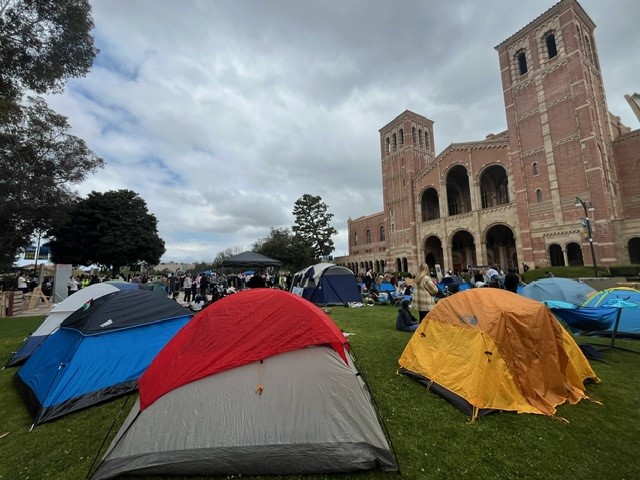
The Los Angeles County Sheriff's Department is set to roll out body-worn cameras for its deputies at the end of the third quarter this year -- five years after the LAPD initiated its own program -- according to a report released Tuesday by the Office of Inspector General.
"LASD has lagged far behind other major police agencies in the incorporation of video technology as a means for police supervision and public accountability," the report by Inspector General Max Huntsman states. "This step forward, slow as it is, is historic."
In comments during a Monday town hall with Palmdale and Lancaster residents, Sheriff Alex Villanueva said Lancaster would be in the first group of five stations to get the new technology.
The sheriff blamed his predecessors and the Board of Supervisors for the delay, and said body cameras have been his priority since day one.
"The previous administration had five years ... of wasted time, wasted opportunities and four different plans, four different studies and nothing ever came to fruition," the sheriff said. "Within that first week, we had a plan ... it was delivered to the board in December of 2018, and this is where the wheels fall off the wagon."
Yet another study was requested, he said, accusing the board of intentionally dragging its feet to prohibit him from getting a "win." The board and the sheriff have wrangled in court and elsewhere over a host of issues, including rehiring deputies terminated for misconduct and failing to turn over documents requested by the OIG.
The supervisors generally insist that they are seeking cooperation, though their exasperation is sometimes evident, while the sheriff seems to believe they have a vendetta against him.
Local
Get Los Angeles's latest local news on crime, entertainment, weather, schools, COVID, cost of living and more. Here's your go-to source for today's LA news.
In the case of body-worn cameras, the policy debates predated Villanueva -- who was sworn in on Dec. 3, 2018 -- and have also characterized the adoption of cameras at other law enforcement agencies, including the LAPD.
A pilot program for the Sheriff's Department was launched in 2014, but plans for a broader roll-out seemed to stall under the weight of questions about when and how to release recordings to deputies and the public, as well as how to pay for storing and managing extensive amounts of data.
As then-sheriff Jim McDonnell, the board, the OIG, law enforcement unions and the Civilian Oversight Commission worked toward a consensus on policy, the Los Angeles Police Department rolled out cameras department-wide.
Though the LAPD initially kept recordings for internal use, the LAPD revised its policy in March 2018 to require public release of video from "critical incidents," such as police shootings, within 45 days.
In high-profile cases, the department has acted more quickly. For example, in the 2018 shootout at Trader Joe's in Silver Lake -- where store assistant manager Melyda Corado was killed by an LAPD bullet during an exchange of gunfire between police and a man suspected of shooting two other people -- LAPD Chief Michel Moore released bodycam video three days later.
The value of video footage couldn't be clearer at a time when protesters nationwide have been enraged into action by the images of George Floyd, a 45-year-old Black man, fighting to breathe while held down by the knee of a white Minneapolis police officer now charged with murder.
In Los Angeles County, money has also been an issue, with McDonnell asking for $55 million in funding and 239 new personnel to run the system. The board chose to focus first on installing fixed cameras in county jails to counter use-of-force against inmates.
The plan ultimately agreed upon by Villanueva and the board in September 2019 carried a cost of roughly $35 million and called for 33 new employees. At that time, county Chief Executive Officer Sachi Hamai said it would take about 19 months to roll out the devices to more than 5,200 deputies and security officers operating out of 58 patrol stations and sub-stations, 84 county facilities and nine community colleges, with full roll-out expected in the first half of 2022.
The contract with the vendor providing the cameras and related services is still being negotiated, according to the OIG.
The unions have since ratified a bodycam policy -- which the department has not yet publicly released -- but the OIG and COC have recommended changes. Citing the sheriff's failure to respond to two subpoenas issued by the COC, the OIG underlined concerns about how the program would be implemented.
"Aggressive resistance to public oversight and review of department conduct suggests policy-based concerns regarding the body-worn camera program are warranted,'' the report stated.
The LASD policy "largely mirrors" that of the LAPD, according to Huntsman. However, where it diverges, it favors deputies, he said.
"There are concerns that the policy grants supervisors and deputies too much discretion in deciding when to turn on or off a body-worn camera and that there is no real accountability for a deputy failing to activate the body-worn camera," according to the OIG report.
Routine audits to identify misconduct are prohibited by the policy. It also allows deputies to review video footage before writing reports, according to the OIG, who added that this raises ``grave concerns'' by the public defender and alternate public defender about deputies fabricating details about what happened.
Despite misgivings, Huntsman strongly recommended moving forward.
"Implementing body-worn cameras is an immediate necessity,'' the report concludes.
Along with Lancaster, the Century, Lakewood, Industry and West Hollywood stations are slated to be the first locations where patrol deputies will be outfitted with cameras.



